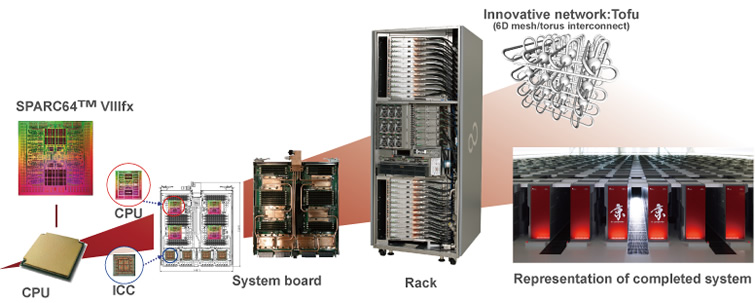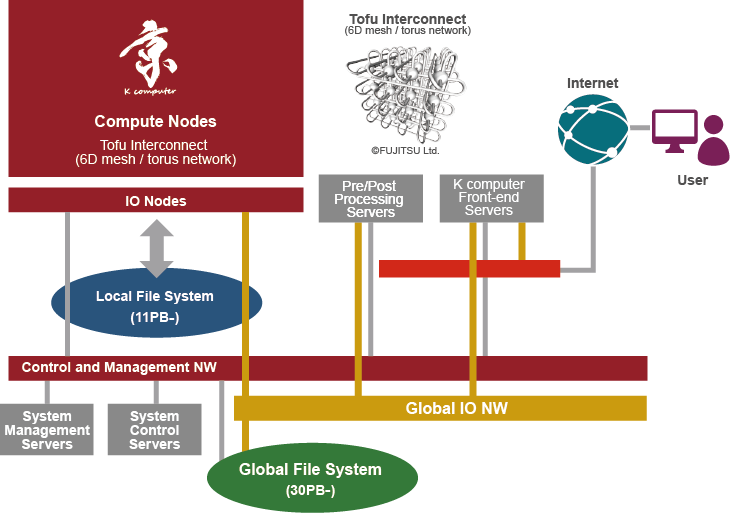

System
System Configuration of the K computer
The K computer achieved its performance target of 10 petaflops (LINPACK) and started full-scale operation in June 2012.
(K computer slide)
(Two-page summary on hardware and software of the K computer)
*For post-K computer development, visit FLAGSHIP 2020 Project website.

Images: Courtesy of Fujitsu Ltd.
Click on the image of the each item for more information
- The system uses scalar CPUs (SPARC64TMVIIIfx, 8 cores, 128 gigaflops) manufactured with 45nm CMOS process technology. To achieve high performance and high scalability to ultra-large-scale system, the CPU additionally supports SIMD (Single Instruction and Multiple Data) processing, and is furnished with functions for instruction retry as well as exhaustive error detection/correction, contributing to high performance and reliability in application execution in an environment with huge numbers of CPUs.
- The network between the compute nodes consists of a direct-connection network*2, ensuring high flexibility and scalability and enabling ultra-large-scale connectivity.
Users can create application programs adapted to either a one-, two- or three-dimensional torus network, contributing to improvements in usability, fault-tolerance and interoperability. - With its water cooling system, the K computer maintains a low temperature in the CPU and other LSIs, minimizing the failure rate and reducing power consumption.
- An ultra-large-scale file system with high functionality, scalable to several hundred petabytes, provides several dozen petabytes for user areas.
- The system adopts a two-level local/global file system with parallel/distributed functions, and provides users with an automatic staging function for moving files between global and local file systems.
- To ensure 10-petaflop high-performance use in an extensive, easy-to-use environment by various researchers and engineers, the K computer supports a Linux-based OS, Fortran which is widely used in science and technology fields, a C/C++ language environment, and the standard library MPI for parallelization, providing versatility and high scalability.
*1 A scalar-type supercomputer is a set of compute nodes with scalar CPUs connected by a network. CPUs operate on data in small chunks in sequential order. Scalar-type supercomputers are today a common style of supercomputer system used throughout the world. These supercomputers are well-suited to computations involving complex data access, such as those involved in structural analyses of nano-scale devices as well as analyses of gene and protein data.
*2 There are two styles of networks, direct-connection networks and indirect-connection networks. In a direct- connection network, the entire network consists of numerous connections between pairs of nodes. In an indirect- connection network, a switch sits between multiple nodes.
A three-dimensional torus network is a kind of direct- connection network where the nodes are organized into a three-dimensional structure, and each is linked to six others, forming a ring structure on each dimension.

K computer slide (powerpoint)
 ●This slide describes the system configuration of the K computer and presents its achievements in major supercomputer rankings.
●This slide describes the system configuration of the K computer and presents its achievements in major supercomputer rankings.
●Please feel free to use this slide in your presentations. You may modify the contents of the slide.
●Language: English
※If you want to use the K computer‘s photo only, please fill in the Borrowing and Reproduction Request Form and e-mail it to aics-koho[at]riken.jp.

